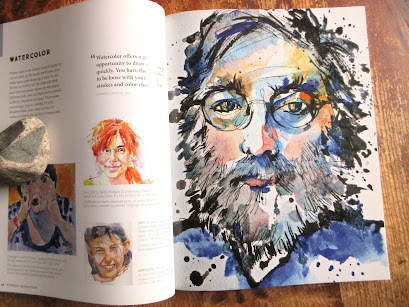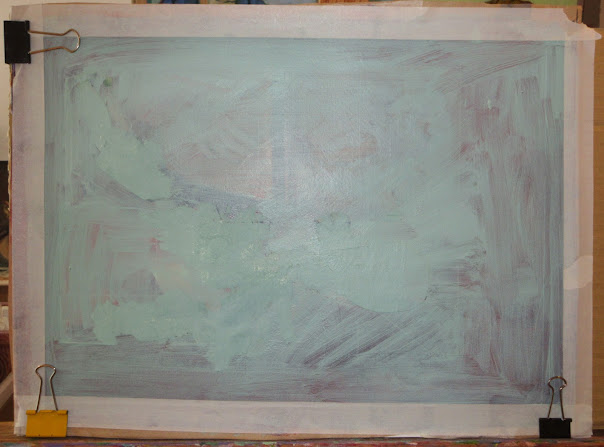Ah, those lazy, hazy, crazy days of summer! I press on with my summer camp project, maybe at a dreamier pace than I began with. Sorting through old studio boxes, I came across a small 8" x 10" sketch I'd made years ago of a favourite spot we used to visit along the Squamish River.
Back then, I had repeatedly tried to make a larger painting but was constantly stymied. Still, this small study brings back so many memories of our cabin days in Upper Squamish. Our own photos are in different boxes, but here's one from a hikers' website, from a slightly different vantage point.
Looking through dozens of on-line images of late 19th-early 20th century Adirondack paintings, I came across this one. Titled "A Mountain River", it made a sure match with my small study for the next in my Empty Frame series.
The artist, John Lee Fitch, proved elusive. I found only scant biographical material that said he was a painting pal of Winslow Homer and Homer D. Martin, the latter previously framed in my series kick-off. I looked high and low for a photo of Fitch, or even a portrait painting by another artist – but no such luck.
Finally, I decided to "do an Adelard" – to seek out photos of Fitch family members, hoping to find a model that might suggest how he looked. These, too, were in little evidence, but then along came a handsome mid-20th century Broadway star, Stephen Douglass Fitch – stage name, Stephen Douglass.
And then, the light dawned. I knew this celebrity in my childhood! Well, "knew" is perhaps too strong a term. In the midst of his early career success, about 1951, Douglass was taking his own Adirondack summer vacation, staying for a while with his sister's family in our little town. Her sons were my pals up the street, one of whom was even named for "Uncle Steve." We watched the Broadway star from a respectful distance as he energetically mowed the family's lawn, singing at the top of his voice, "Daisy, Daisy, give me your answer, do." And now I've found him on YouTube!!
I'd already decided that my next get-acquainted art medium would be watercolour and watercolour markers in the wild spirit of "Portrait Revolution." Whether or not Uncle Steve was related to John Lee Fitch (one family was from Ohio, the other from Connecticut), he was chosen to play the lead role! He was an actor. He could handle this drama.
I rolled up my sleeves, carefully filled the watercolour "pens" and set to work.
Oh, no. The outcome was SO bad, I didn't even stop to take a photo. I painted most of it out and grabbed some intensely coloured oil pastels (they're like luscious crayons).
Did this help??
Cue the chorus: NO! I could almost hear Stephen Douglass saying, "WHEN is my regular makeup artist coming back from vacation??!"
Such a good-looking guy didn't deserve that – so just for old times' sake, I did a simple straight-forward "capture" with only two markers, one black and one white, on grey paper. Here he is: "Framed: Stephen Douglass."
Then I shifted gears for a pencil sketch of the proposed landscape.
Here's a preliminary paint job, done two days later, in which I'm already making corrections -- which is okay; it's a process.
Another day or two more, and I realized I'd made a huge mistake – starting too dark. It's a truism for most kinds of paint that it's easier to darken the lights than to lighten the darks.
The dark/light shades in this landscape, as well as the range of blues and greens, would make a whole semester's study in Landscape 101.
So….here we are, the point at which I've declared, "I can't make this any better than it is, and I might make it worse." Title: "Mt. Ashlu from Anderson Beach," Empty Frame Series, copyright 2023. For a mountaineer's view of the high peaks of Mt. Ashlu, see here.
There's always something to be learned. My hassles with this current attempt demonstrated why I still have only a small study to show for this stretch along the Squamish River. Well, as many have said, The Journey is the Destination. Curiously enough, I found a reminder of this good counsel in the newspaper scrap I'd been using when I first set up the watercolour markers. Just read it upside-down.
So – onward! And while my beat-up gardening shoes aren't suitable for trekking either the Adirondacks or the Tantalus Range, my brand-new shoelaces bring a smile to my face. Don't you love the colour combo?!?






























